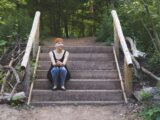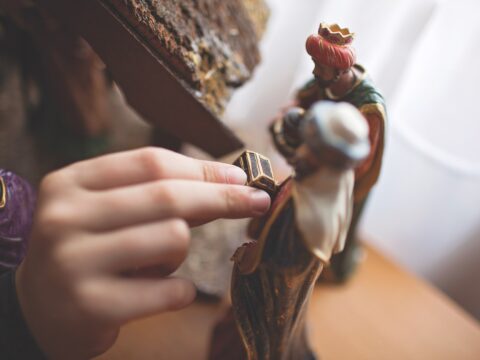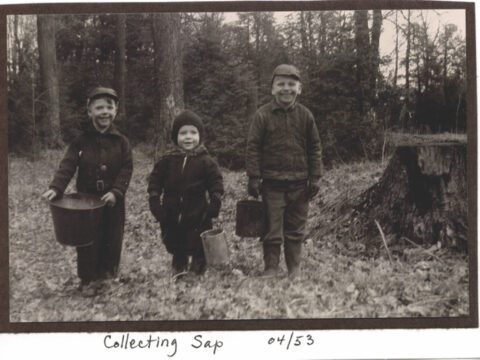“Fear not…. ” As I focused my eyes on the swath of dark blue above me, stars came into view. I blinked, remembering where I was: in a church, on a hill above Bethlehem, on Christmas Eve.
Bishop Munib Younan continued: “Palestinians and Israelis today face a common enemy: fear. In the absence of justice and peace, the common denominator is fear. Fear of the other. Fear for the future. Fear that freedom is not coming. Fear that children will grow in hatred. Fear of insecurity. Fear of the occupation. Fear is our common prison that keeps us locked up in cycles of mistrust and shattered dreams.”
Candlelight flickered inside the Evangelical Lutheran Christmas Church. Tucked into a hard pew between a 30-something German woman and a Palestinian teenager, I looked up again. The vaulted blue ceiling sparkled with gold stars. Pale-coloured stone stretched downward, framing stained glass windows. A small Christmas tree stood to the right of the altar. A few musicians began to play.
I blinked again. How did I come to be in Bethlehem at Christmastime?
As a child growing up in Toronto in the 1970s and ’80s, I revelled in the Christmas season. Each day, I dutifully opened just one window in my Advent calendar, the tiny doors revealing tinier images of shepherds, angels, magi and other sure signs that Christmas was approaching. Each year, I watched the 1954 classic film White Christmas and played my favourite Christmas records: Bing Crosby and Barbra Streisand. All December, I would wait and pray for snow, which fell rarely in southern Ontario. In the dark evenings, I would work on home-made gifts and then turn off inside lights to check for snowflakes outside.
I focused so much energy on those preparations and the waiting. I had no fear. I had anticipation and longing for Christmas Eve and for snow.
For much of my adulthood, I have lived in Alberta. We typically have a white Christmas, and I feel very lucky.
But last year, my Advent preparations were anything but snowy white. Instead, I was enjoying autumn-like weather in East Jerusalem. I had taken a leave of absence from my job in Edmonton as a university researcher and educator to serve as an ecumenical accompanier with the World Council of Churches’ Ecumenical Accompaniment Programme in Palestine and Israel (EAPPI).
Landing in Tel Aviv in early December, I was driven by minivan through the hills to West Jerusalem, across the 1949 Green Line into Israeli-occupied East Jerusalem, then up to the place I would call home for the next three months: a centuries-old bungalow with thick stone walls located a block north of the Old City of Jerusalem. After a year of preparation, the waiting was over. I did have some fear. I had landed in the occupation.
The role of an ecumenical accompanier is to live alongside people who are seeking to end the Israeli government’s occupation of Palestine and to achieve a just peace. As members of EAPPI Group 38, we came from nine differen tcountries — some of us motivated by our faith, others by a secular sense of injustice. For three months, we would live with and learn from Palestinians (mostly Muslims and some Christians) and from Israelis (including religious and secular Jews). We had arrived in response to the 2001 call from the heads of Jerusalem churches to provide an international presence at Israeli-armed checkpoints, Bedouin villages, non-violent demonstrations and more.
My immediate team was made up of four people: a Swede, a German, an American and me. We were placed in Jerusalem. Among other tasks, we would monitor for human rights abuses at Qalandiya Check- point between East Jerusalem and the West Bank.
As we began the training that would prepare us for our roles as accompaniers, I started to orient myself to these new surroundings. Though I’d travelled to Jerusalem in May 2009, I still had much to discover — especially in this Advent season. Walking down a dusty street or turning a corner in a busy market, I would be surprised to see signs of Christmas popping up, much like those images from the Advent calendars of my childhood.
For example, on one of my first afternoons in East Jerusalem, I headed toward Jaffa Gate, an entrance to the Old City. The air was filled with dust as archeologists and their teams dug into the ground behind a roped-off area. Israeli soldiers directed pedestrians toward a detour. Turning down a narrow street, I came face to face with an inflatable Santa and a Santa mannequin outside Rossini’s restaurant.
Soon after, nighttime temperatures began to dip, and we turned on electric heaters and piled on layers of clothing. One evening, I read a forecast for snow! Jerusalem is at a relatively high elevation compared with Tel Aviv to the west and the Dead Sea to the east. A few times, tremendous winds, rain and sand did batter our stone house — but alas, no snow.
Early in the mornings, I walked the streets and learned to step out of the way of small tractors — “mechanical donkeys” — and wheeled carts laden with goods for Palestinian shops. Passing by stores opening directly onto the streets, I marvelled at pyramids of spices. Would I recognize frankincense or myrrh, should either appear?
Other times, I’d be walking along and noticing the hijabs worn by Muslim teen girls and women, or the kippot (skullcaps) sold for Jewish boys and men in the marketplace. But then I’d come upon a string of festive lights or a decorated Christmas tree. Or I’d walk past merchants playing Celine Dion or Bryan Adams Christmas songs over their loudspeakers.
Another sign that Christmas was on the horizon: increasing numbers of tourists appeared on the main thoroughfares in the Old City. I knew them by their neon-coloured baseball caps or their richly patterned African textiles. As pilgrims, they gathered along the Via Dolorosa and in front of the Church of the Holy Sepulchre.
Then, on Dec. 13, the Christmas season burst into my consciousness in a big way. It was Santa Lucia Day, and the Swedish ecumenical accompaniers invited me to join them at the Swedish Theological Institute for a celebration. Arriving at the party was like walking into a Christmas colouring book. As I sampled a saffron-splashed Santa Lucia bun, the sound of women and children singing floated down the central staircase. A tall young woman appeared on the steps, dressed in white with a red sash around her waist and a wreath of lit candles upon her head. She led a choir of women and children in white. The girls wore white dresses with red sashes and green wreathes of battery-operated candles on their heads. The boys wore white robes and pointed hats adorned with gold stars. And the littlest figure was dressed in a gingerbread robe.
I loved the wonder of that evening and marvelled at the mix of people celebrating together: Christians of various denominations, Jews and Muslims; some locals and many internationals living and studying in West and East Jerusalem. For that evening, a festive feeling worked its way into my body.
A few days later, our group travelled to Bethlehem to help celebrate the first anniversary of the release of the Kairos Palestine document, a statement of faith from Palestinian Christian leaders calling for an end to the Israeli occupation through non-violent means including boycott, divestment and sanctions.
Although the distance from Jerusalem to the West Bank is relatively short at 10 kilometres, the trip requires passing through Checkpoint 300. As I stepped off the bus to walk through the pedestrian gates, I tried to project an air of confidence even though my heart was pounding. We showed our passports to the young Israeli soldier behind bullet-proof glass and then made our way through a maze of turnstiles. From there, we crossed what appeared to be an empty parking lot. Various sets of railings hinted at the long lines that form early each morning as Palestinians wait to enter East Jerusalem for school, work and medical appointments. Then we passed through more turnstiles and the Israeli government’s separation wall.
The crossing took us less than 10 minutes. Travelling in the opposite direction typically takes longer. For Palestinians crossing into East Jerusalem, it’s not unusual to line up at 2 a.m. to await the checkpoint’s 4 a.m. opening, only to wait another two hours to reach the other side.
Arriving in the West Bank, we made our way to the International Center of Bethlehem. The centre is an ecumenical hub of activity, and its general director, Rev. Mitri Raheb, is one of the authors of the Kairos Palestine document. In the centre’s theatre, speakers discussed their hope that by 2011, the document’s second anniversary, they would be closer to peace.
After the event, we wandered through Bethlehem and onto Manger Square. More signs of Christmas appeared, though they felt more ominous than festive. On our way into town, we saw heart-stopping graffiti painted onto the separation wall: “Merry Christmas World from Bethlehem Ghetto.” Then we visited the Holy Land Arts Museum store owned by Joseph E. Giacaman & Sons Co., where we beheld beautiful olive-wood nativity sets. We met the store’s owner, Joseph, his wife, Mary, and one of their sons, Elias, who helps to manage the business. Elias is also a fine craftsman and showed us an unusual nativity set he’d created. Instead of setting the figures of Mary, Joseph and Jesus in a stable, he’d set them against the looming separation wall.
It was a moment of insight. This place that so many around the world associate with Christmas, and that so many carols endearingly describe, was dominated by a concrete wall, double the height of the Berlin Wall. I learned that Elias had not been granted a permit to cross Checkpoint 300 to visit Jerusalem, despite seven years of applications. And yet, I would cross that same maze of Israeli soldiers and turnstiles twice that day.
With our training as ecumenical accompaniers complete, I and the other Jerusalem team members were ready to step into our roles.
On Dec. 21, multiple home-demolition alerts arrived on my mobile phone. We hurried to the site described in the text message as “Demolition ongoing of a Palestinian (inhabited) home in Ras Al Amud in East Jerusalem.” Upon our arrival, a young Palestinian man told us, “You’re too late.” A heavy excavator appeared in the street rolling toward us, accompanied by Israeli riot police. We turned into a driveway to find a house constructed out of two shipping containers, welded together and perched on stilts. A family of 13 registered Palestinian refugees had owned the home and the land for six years — and now they were tearing it apart.
This was a forced self-demolition. The family had received a written warning from the Israeli authorities informing them that if they did not move the house by the end of Dec. 21, the riot police and demolition equipment would return on Dec. 22 to flatten the entire structure. The family had already paid a fine of 20,000 shekels (C$5,600) to the Israeli government for constructing their home without a building permit — a document that is practically impossible for Palestinians to obtain in East Jerusalem. They had begun the self-demolition so that they would not be charged an additional demolition fee of 100,000 shekels (C$27,900). They planned to move the containers that same night.
As we turned to leave, the father said, “We have no home. Pray for us. Thanks for coming. Maybe because you come here and are in solidarity [things will be better].” As we left, one of the younger sons arrived home from school. He looked stunned.
This family’s tragedy occupied my thoughts.
What was this about? Displacement? How did this fit with the Christmas story? Sorry, there is no room for you here in this “inn,” in this place.
Two days later, I attended a communion service at Sabeel, the Ecumenical Liberation Theology Center in East Jerusalem. Sabeel founder Rev. Naim Ateek facilitated a discussion for those in attendance, asking us to consider the following questions: What is righteous in a time of Israeli occupation and illegal annexation of East Jerusalem? How might we rise above unjust laws? He invited us to remember that “Emmanuel,” the name given to Jesus, means “God with us.” We are not alone. We sat incommunion, witnessed by a Christmas tree.
I blinked again. Bishop Younan continued: “It is a fear that will only ever vanish when there is peace based on justice and reconciliation built on forgiveness. We proclaim that such a just peace is possible today. We pray that all political leaders will seize the opportunity before it is too late. The same message of the first Christmas rings true today: ‘Fear not!’ There is a child who was born into a world of fear in order to take away that fear and to bring peace to Earth and goodwill to humankind.”
As the service came to an end, the electric lights inside the Evangelical Lutheran Christmas Church were turned off. I looked around in the darkness. One by one, we lit taper candles and a new, flickering but persistent light grew. We were a community of Christians on a hill in Bethlehem. Despite decades of raids, curfews and forced evictions, Palestinian Christians had gathered in this church to celebrate Christmas Eve once again. And many of the internationals who joined them on that Christmas Eve had come to show that the international community does care and does believe that peace will come.
For me, the path from snowy Edmonton to that hill in Bethlehem on Christmas Eve was guided by a sense of injustice and tinged with fear. I had been afraid of not passing inspection upon arrival at Ben Gurion International Airport. Of provoking the Israeli soldiers at Qalandiya Checkpoint as I advocated for the humanitarian gate to be opened once again. Of drawing curses from motorists as I stood with the Israeli Women in Black in West Jerusalem. Of attracting the attention of Israeli riot police.
Yet the Palestinian teenager sitting beside me on Christmas Eve was not letting fear drown her.
Together, we joined the procession into the night air to a rooftop courtyard. We introduced ourselves and exchanged wishes for a peaceful Christmas. I learned that she and her family are facing innumerable attempts by Israeli authorities to annex their familial land outside Bethlehem. From her quiet presence that night, I learned how to stand a little taller despite all that I would witness that winter.
I did not gasp in wonder at the sight of Christmas snow that December. However, on that hilltop in Bethlehem, my heart did break open, not with fear, but with a shared dream of a just peace.
***
This story first appeared in The United Church Observer’s December 2011 issue with the title “Christmas in the Holy Land.”
Sherry Ann Chapman is a member of Southminster-Steinhauer United in Edmonton and a university researcher-educator.















